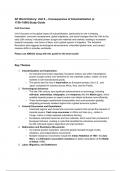AP World History: Unit 6 – Consequences of Industrialization (c.
1750–1900) Study Guide
Unit Overview:
Unit 6 focuses on the global impact of industrialization, particularly its role in shaping
imperialism, economic development, global migrations, and social changes from the 18th to the
early 20th century. Industrial powers sought raw materials and markets, leading to increased
imperial conquests, new forms of labor, and a global system of migration. The Industrial
Revolution also triggered technological advancements, intensified global trade, and caused
massive shifts in societies worldwide.
Please use AMSCO along with this guide for the best results
Key Themes
1. Industrialization and Imperialism:
○ As industrial economies expanded, European nations and other industrialized
powers sought control over territories for raw materials (cotton, rubber, oil) and
markets to sell manufactured goods.
○ This period saw the rise of imperialism as European powers, the U.S., and
Japan competed for colonies across Africa, Asia, and the Pacific.
2. Technological Advances:
○ The late 19th century saw significant advancements in technology, including
railroads, steamships, telegraphs, and weaponry (like the Maxim gun), which
enabled imperial powers to assert control over distant territories more efficiently.
○ These technologies transformed transportation and communication globally,
integrating previously isolated regions into a global economic system.
3. Colonial Economies and Exploitation:
○ Colonized regions were forced into economic systems that served the interests of
imperial powers. Cash crop economies in Africa and Asia (e.g., rubber in
Congo, cotton in India) replaced subsistence farming.
○ Europeans extracted resources and raw materials, which were then processed in
European factories, creating a cycle that benefited the colonizers economically
but left colonized regions dependent and impoverished.
4. Nationalism and Resistance Movements:
○ As imperial powers expanded, colonized people resisted through revolts,
rebellions, and independence movements.
○ Notable resistance movements include the Indian Rebellion of 1857, the Zulu
Wars, and Ethiopia's successful resistance to Italian imperialism at the Battle
of Adwa (1896).
5. Labor, Migration, and Settlement:
, ○ Industrialization and imperialism drove significant global migrations, both
voluntary and coerced. Many migrants sought work opportunities in factories or
plantations in distant lands.
○ Indentured servitude replaced slavery in many regions after its abolition.
Workers from India, China, and Japan migrated to places like the Caribbean,
Southeast Asia, and South Africa under harsh labor conditions.
6. Social Changes:
○ The social impact of industrialization extended beyond the colonized regions. In
Europe and the industrialized world, the rise of the working class, urbanization,
and the labor movement transformed society.
○ Reforms such as labor laws, women's rights movements, and socialist
ideologies gained momentum in response to the harsh conditions of industrial
capitalism.
Key Concepts and Events
1. The Scramble for Africa:
● Berlin Conference (1884-1885): European powers met to divide Africa into colonial
territories without regard for existing ethnic or political boundaries. This resulted in the
rapid colonization of nearly the entire continent by European powers.
● Colonial Exploitation: Europeans established cash crop plantations, extractive
industries (e.g., mining for gold and diamonds), and infrastructure projects like railroads
to exploit Africa's resources for their benefit.
2. Imperialism in Asia:
● British Raj in India: Following the Indian Rebellion of 1857, Britain tightened its control
over India, making it a formal colony and extracting wealth through cash crops (cotton,
tea) and raw materials.
● Opium Wars (1839-1842, 1856-1860): Britain fought two wars with China to force the
Qing Dynasty to allow the sale of opium. The wars resulted in the Treaty of Nanking,
which ceded Hong Kong to Britain and opened Chinese ports to European traders.
3. Imperialism in Southeast Asia and the Pacific:
● French Indochina: France colonized modern-day Vietnam, Laos, and Cambodia,
exploiting their rubber plantations and rice production.
● Dutch East Indies: The Dutch controlled Indonesia, where they implemented the
Cultivation System, forcing farmers to grow cash crops like sugar and coffee for export.
● Hawaiian Annexation: In the Pacific, the United States annexed Hawaii in 1898,
expanding its influence in the Pacific region for strategic military and economic reasons.




